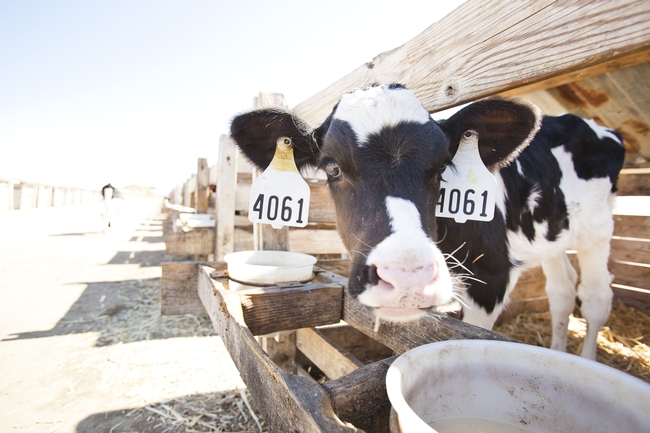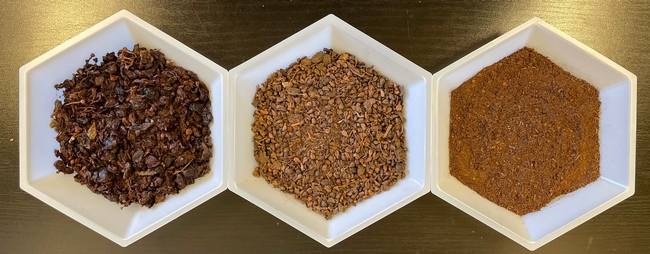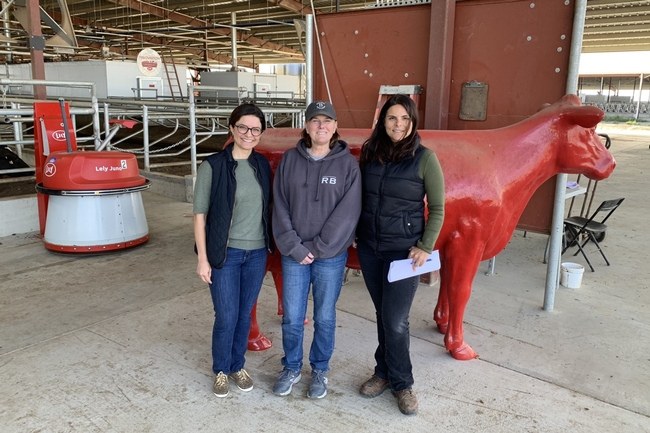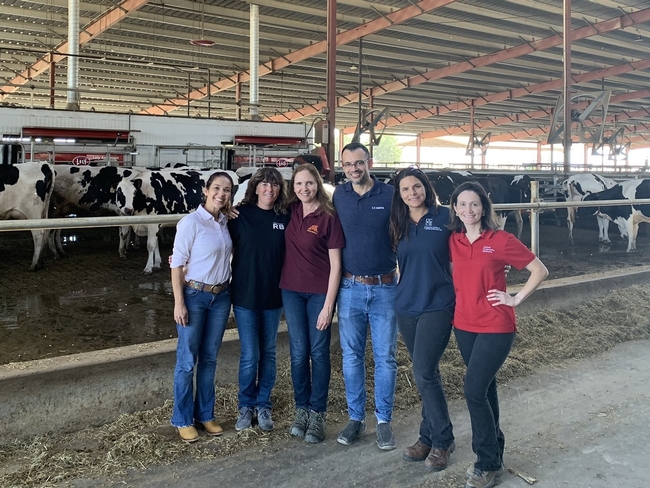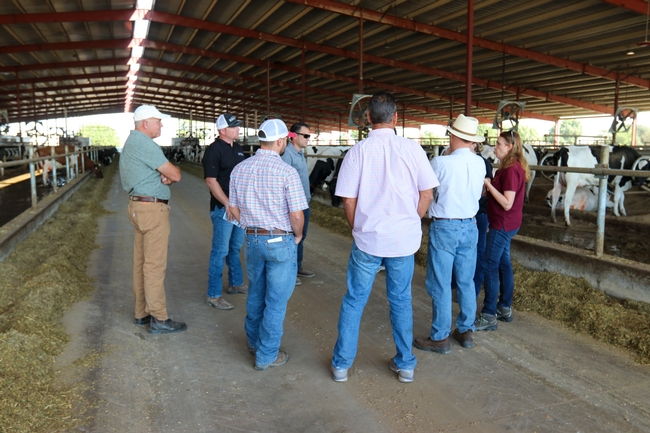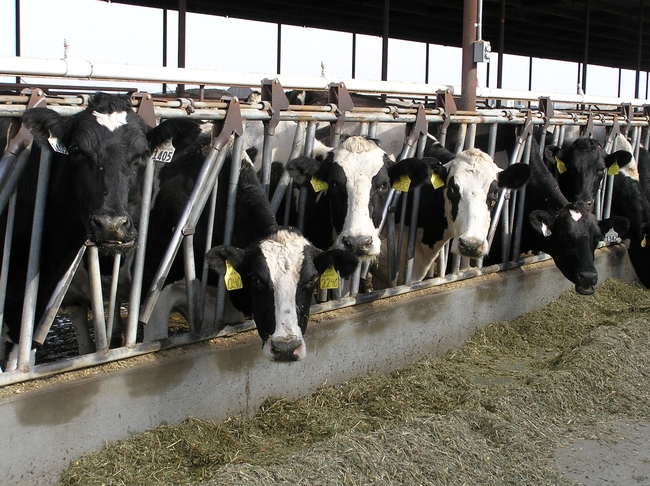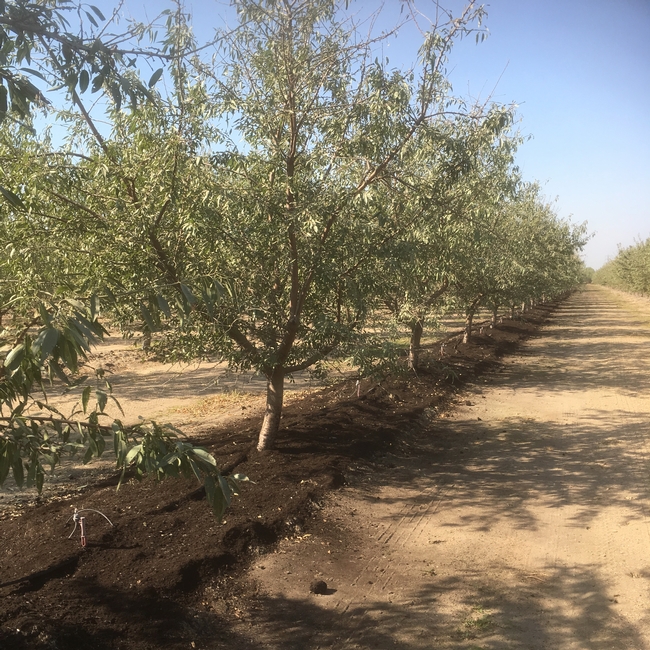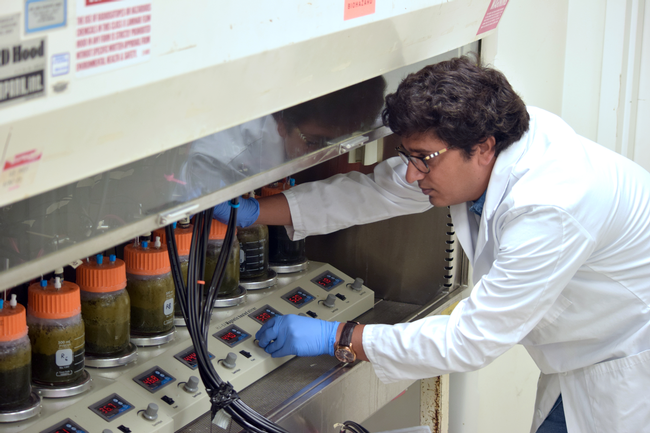Posts Tagged: dairy
Grape seeds, stems and skins can reduce dairy cattle emissions
Low-cost wine industry additive also improved feed efficiency and milk quality
Researchers at University of California, Davis, added fresh grape pomace left over from winemaking operations to alfalfa-based feed for dairy cows and found that methane emissions were reduced by 10% to 11%.
The preliminary findings could offer a low-cost sustainable pathway for vineyards to reduce waste while helping dairy operations maintain quality while cutting back on emissions of methane, which is a powerful greenhouse gas.
“This is the first time anybody has shown that this can work in California,” said Ermias Kebreab, an animal science professor and associate dean of global engagement at UC Davis. “You're reducing emissions, you're improving the quality and it may also reduce the cost of production.”
The pilot research project, which will be detailed in a paper later this year, also found that mixing in grape pomace improved feed efficiency and increased healthful fats, said Selina Wang, an associate professor of Cooperative Extension in small scale fruit and vegetable processing.
“We found that the feed with the additive of grape pomace changed the fatty acid composition of the milk and, in particular, increased the polyunsaturated fats, which are the main fats in grape pomace,” Wang said. “This suggests that supplementing the feed with an optimal fatty acid profile may have positive impact on the fatty acid profile of the milk and increase their health benefits.”
Symbiotic commodities?
In 2022, California was the leading dairy producer in the country, generating $10.40 billion in sales, while 90% of wine production came from the Golden State, with a market value of $5.54 billion.
Processing grapes for wine generates thousands of tons of waste in the form of grape pomace, which consists of leftover seeds, skins and stems. Dairy and livestock are responsible for more than half of the state's methane emissions, owed largely to cow burps.
They are the top two agricultural commodities in California, according to state production statistics, and reducing waste and emissions for both industries are key to the state meeting its climate goals.
Tannins for emission reductions
Wine grapes are high in fats and tannin, which is known to reduce methane emissions, so Kebreab sought to test if adding grape pomace to feed could have a positive effect while not adversely affecting production.
“It's a byproduct that's not being used much,” he said. “This is something that can be included in our efforts to try to reduce emissions.”
A mix of feed options
To do the research, scientists worked with Holstein dairy cows and gave the animals feed consisting of alfalfa, wheat, almond hulls, cottonseed and grain. After two weeks, the cows were split into three groups: A control group with no change in diet, another where the feed combination included 10% grape pomace and a third that received 15% grape pomace.
Every four weeks, the cow groups would change feed combinations.
They were fed twice daily by postdoctoral students and interns, and emissions were monitored daily. Milk production was documented in the morning and evening and milk samples were collected weekly to analyze for fat, protein, lactose and other measurements, which showed no differences between the control and other groups.
Methane and hydrogen emissions were reduced compared with the control group, suggesting that grape pomace reduced enteric emissions without affecting production.
“I think the dairy industry will be very interested in this,” Kebreab said. “Sometimes when you're using additives, they have palatability issues. With grape pomace, they absolutely love it.”
Next on the list is a trial with olive pomace and working to understand the mechanism that reduces emissions. “If we have a better understanding of the mechanisms, we can select the feed additive or a mix of feed additives to reduce dairy cattle emissions and make dairy milk healthier while making use of the agriculture byproducts,” Wang said. “There's a lot of room to grow in this space and we're excited about this work.”
The research was supported by the California Dairy Research Foundation.
This article was first published on the UC Davis news site.
UCCE advisor Bruno guides, learns from dairies switching to milking robots
Automatic milking systems increasingly used in California amid labor challenges
When third-generation dairy farmer Shonda Reid first saw a milking robot at a farm show 13 years ago, she immediately recognized that the technology represented the future. Her father, however, took a bit more convincing.
“I came home and showed him and said, ‘This is what we need to do.' And he thought I was kidding!” said Reid, dairy and farm manager for Fred Rau Dairy, which has a herd of 1,400 milk cows in Fresno County.
Years later, after the family had visited several dairies using automatic milking systems (AMS) across the U.S., they installed their first six robots in November 2021. By fall 2022, they had 24 robots, evenly split between two newly built “free stall” barns where the cows can freely go to the milking machines.
As Fred Rau Dairy was one of the first in California to implement AMS at such a scale, Reid and her team have been instrumental in growing practical knowledge on these systems. She also has been a valued partner to Daniela Bruno, University of California Cooperative Extension dairy advisor for Fresno, Madera and Kings counties.
“Automatic milking robots are not a new technology, but it's new to California,” said Bruno, noting that the milking robots were first used on small, family-run farms in Europe, where the technology granted family members more time for rest and other pursuits.
To better understand the feasibility of milking robots for large dairies in California, Bruno – alongside former UC Davis School of Veterinary Medicine professor Fernanda Ferreira, University of Minnesota researcher Marcia Endres and other collaborators – began a project in 2020 to study the risks and opportunities of automated systems.
“The information is extremely useful for California producers to make informed decisions about implementing AMS on their facilities,” said Denise Mullinax, executive director of the California Dairy Research Foundation, which supported the effort through a competitive grant. “Cow care, labor requirements and profitability are key issues for producers, and CDRF was pleased to support this project which assists producers in understanding how AMS may impact those areas on their facility.”
Dairy farmer: ‘We needed to make some changes'
The project produced a paper analyzing existing research on automatic systems, which have been more widely used in the Midwest, where there are more small-scale, family-run dairies. In 2020, there were only 14 “box robots” in California, according to Bruno. Now there are about 200 across California – and both Bruno and Reid cited labor challenges as the primary reason for the increased use of automated systems.
“California suffers from labor quality and quantity issues,” Bruno said. “By bringing robots to California, you can minimize those problems.”
Higher costs of hiring and retaining employees, driven in part by new labor laws, are one factor. And then there's the reliability and availability of labor, as fewer people are willing to do the physically demanding work of conventional milking.
“People just don't want to milk in a flat barn [a conventional setup where the employee works at the same level as the cow] – there's a lot of kneeling, squatting, that type of thing – it's pretty tough on the body,” Reid explained.
Faced with labor shortages and mounting regulatory burdens, Reid said Fred Rau Dairy had to make the leap to automated systems to keep the 80-year-old dairy operation running.
“We needed to make some changes, or we're going out of the dairy business,” she said.
In a survey conducted by Bruno and her colleagues of large dairies using AMS across the U.S., a majority of the 29 respondents reported reductions in labor costs – but survey results did not offer a definitive picture on whether AMS improved bottom-line profitability.
Calmer, healthier cows
Nevertheless, most of the survey respondents said they were generally happy with their transition to automatic systems.
“It's totally met our expectations, and cow health has gotten much better, too,” Reid said.
In a typical conventional system where cows are outside in “open corral” pens, dairy employees must cajole the cows into the milking parlor. But within a “free stall” barn where the cows can voluntarily go to the milking robots when they want, as often as they want, the animals are much less stressed.
“When you think about cow handling, if you have robots, you don't have anybody pushing and screaming at them to walk to the parlor,” Bruno explained. “You have less cow-people interaction so they are more calm; there is less stress.”
In the survey of large dairies using milking robots, more than 90% of the respondents said their cows were calmer. Reid also noted that many people have noticed how calm their cows are in the free stall barns.
“They're not skittish, you can walk in and they don't run,” Reid said. “They'll just watch you or they'll even come up and start licking on your jacket or shirt.”
Bruno also said that many of the large dairies reported fewer cases of mastitis and other diseases, less lameness, and greater milk production. But she added it's hard to know whether the benefits can be attributed to the robots and their real-time monitoring technology – or to changes in the physical environment (cows save energy in the free stall barn setup, versus the open-corral system that requires walking to the milking parlor).
Dairy producers seek counsel on potential transition
Less bovine travel from outside to inside was a boon for Fred Rau Dairy during last year's unusually wet winter.
“Even if it's just a couple of weeks of rain, that mud and manure and everything – you do what you can, but oh my gosh – it's a mess,” said Reid, noting that easier facility maintenance during extreme weather was another benefit of switching to automatic systems within free stall barns.
Reid shared many of her experiences with attendees of an AMS Field Day in October 2022, arranged by Bruno, Ferreira and their collaborators. About 60 farmers, researchers, industry representatives and consultants visited Fred Rau Dairy and Jones Dairy in Merced County.
If a dairy producer is considering implementing automatic systems, Reid recommends that they research all their options, visit dairies that use the systems, and check who in their area would be providing service and technical support.
And there are crucial workforce considerations, as dairy workers must learn an entirely new set of skills and processes. Instead of spending their time fetching the cows, prepping them and milking them in the parlor, workers might need to gather and interpret data from the robots. “Cow people,” as Reid puts it, must become computer people.
“You have a group of people who have been with you for a while, and you hope that they can transition to the new technology of what you're doing,” Reid said.
During this technological transition, and on the myriad other challenges that dairy operators face, Reid said she is grateful for Bruno's expertise and responsiveness.
“If there's something that I need, she's been really good about trying to help – or putting me in contact with the right people,” she explained. “I've enjoyed working with her.”
The AMS project team also includes UC Davis School of Veterinary Medicine professor Fabio Lima, postdoctoral researcher Thaisa Marques and former postdoctoral researcher Camila Lage.
UC ANR offers seminars, citrus tour at World Ag Expo
UC Dairy Series
A series of dairy seminars will be offered by UC Agriculture and Natural Resources scientists at the World Ag Expo. Presentations will cover the latest research on almond hulls as dairy feed, water management, nutrient management, manure management and much more. See the schedule below.
Tuesday, Feb. 8, 2022
Seminar Trailer 2
Session 1: Nutrient Management & Manure Treatment Technologies
Tuesday, 1:00 – 1:55 p.m.
1 p.m. – Joy Hollingsworth, UC Cooperative Extension nutrient management and soil quality advisor for Tulare, Kings, Fresno and Madera counties
Nutrient management with digester effluent
1:15 p.m. – Anthony Fulford, Ph.D., UC Cooperative Extension nutrient management and soil quality advisor for Stanislaus, Merced and San Joaquin counties
Incorporating vacuumed manure into your nutrient management needs
1:30 p.m. – Nick Clark, UC Cooperative Extension agronomic cropping systems and nutrient management advisor for Kings, Fresno and Tulare counties
Nutrient management with other advanced treatment technologies
1:45–1:55 p.m. – Q&A session
Session 2: Manure management options on your dairy
2–2:55 p.m.
2 p.m. – Betsy Karle, UC Cooperative Extension dairy advisor for Glenn, Butte, Tehama,
Shasta, Sutter and Yuba counties
CDFA's Alternative Manure Management Program - where to start
2:15 p.m. – Frank Mitloehner, Ph.D., UC Cooperative Extension specialist in livestock systems and air quality, UC Davis Department of Animal Science
Manure technologies & pre/post greenhouse gas emissions
2:30 p.m. – Ruihong Zhang, Ph.D., UC Davis professor in the Department of Biological & Agricultural Engineering
Novel technologies for manure management on dairies
2:45–2:55 p.m. – Q&A session
Wednesday, Feb. 9, 2022
Seminar Trailer 2
Session 3: Feeding the California Dairy Herd
1–1:55 p.m.
1 p.m. – Jennifer Heguy, UC Cooperative Extension dairy advisor for Stanislaus, Merced and San Joaquin counties
Almond hull usage on California dairies
1:15 p.m. – Ed DePeters, Ph.D., UC Davis professor in the Department of Animal Science
Almond hulls - the story continues
1:30 p.m. – Dan Putnam, Ph.D., UC Cooperative Extension specialist in the UC Davis Department of Plant Sciences
Low lignin alfalfa considerations for yield & feed quality
1:45–1:55 p.m. – Q&A session
Session 4: Water-wise dairying
2–2:55 p.m.
2 p.m. – Nick Clark, UC Cooperative Extension agronomic cropping systems and nutrient management advisor for Kings, Fresno and Tulare counties
Sugar beet and safflower – yield, water use and nutrient management considerations
2:15 p.m. – Mark Lundy, Ph.D., UC Cooperative Extension specialist in the UC Davis Department of Plant Sciences
Maximizing water productivity from winter small grains in California
2:30 p.m. – Khaled Bali, Ph.D., UC Cooperative Extension irrigation water management specialist at Kearney Agricultural Research and Extension Center
Deficit irrigation and winter groundwater recharge in alfalfa
2:45–2:55 p.m. – Q&A session
Need continuing education unit credits?
American Registry of Professional Animal Scientists (ARPAS): 1 CEU/session; 4 total available
Certified Crop Adviser: 2 CEU available
Nutrient Management: 1 CEU (Sessions 1 & 2)
Soil & Water Management: 1 CEU (Session 4)
California Department of Food and Agriculture's Irrigation and Nitrogen Management Program: 2 CEU available
Nitrogen Management: 1 CEU (Sessions 1 & 2)
Irrigation Management: 1 CEU (Session 4)
Feb. 10 citrus tour (9:30 a.m.–3:30 p.m.)
The citrus tour will visit two locations: University of California Lindcove Research & Extension Center and McKellar Family Farms.
Established in 1959, the UC Lindcove REC has more than 100 acres of citrus in the heart of the San Joaquin Valley. At the center, researchers conduct studies on citrus varieties, horticultural techniques and pest management. The UC Lindcove REC portion of the tour will include a display and tasting of citrus varieties.
Lunch is provided at McKellar Family Farms, where visitors will tour the citrus orchards, view equipment and get a better understanding of the process from tree to table. By the end of the tour, visitors will have an understanding of how much care and forethought goes into producing top-quality fruit, in addition to the research conducted to improve growing conditions.
Tour tickets cost $45 and include choice of lunch. For more information, visit https://www.worldagexpo.com/attendees/agriculture-tours.
Dairy’s Net Zero Initiative gets boost with $10 million research grant
The Foundation for Food & Agriculture Research has awarded a $10 million grant to support U.S. dairy's Net Zero Initiative as a critical on-farm pathway to advance the industrywide 2050 Environmental Stewardship Goals set through the Innovation Center for U.S. Dairy.
In California, UC Davis and UC Agriculture and Natural Resources scientists will collaborate on the nationwide project addressing carbon sequestration, soil health and nitrogen management.
"The Foundation for Food and Agricultural Research grant in partnership with Soil Health Institute and Dairy Research Institute are funding research that will positively impact the future of animal and plant agriculture in a world with increasingly limited natural resources,” said Deanne Meyer, UC Cooperative Extension specialist based at UC Davis, who studies livestock waste management.
Working with California dairy forage and almond producers, UC Cooperative Extension scientists and technicians will evaluate and demonstrate the impacts of using manure products as fertilizer in combination with more traditional soil conservation practices.
“With this research, there's a potential to expand the use of dairy manure products beyond forage crops to crops such as almonds,” said Nick Clark, UC Cooperative Extension farm advisor for Fresno and Tulare counties. “We expect results to demonstrate that groundwater quality and quantity can be protected and preserved, and crop yields can be maintained without increasing net greenhouse gas emissions from crop production.”
Clark added, “We look forward to working with our local producers and connecting with our national partners and collaborators to examine and demonstrate the best practical solutions that science has to offer for farming in tomorrow's world."
California dairy operators who would like to participate in the experiment may contact Clark for more information at neclark@ucanr.edu.
Data from the “Dairy Soil & Water Regeneration: Building soil health to reduce greenhouse gases, improve water quality and enable new economic benefits” project will be broadly shared among the dairy community. The six-year project will provide measurement-based assessments of dairy's greenhouse gas footprint for feed production. It will also set the stage for new market opportunities related to carbon, water quality and soil health.
“Addressing the U.S. dairy industry's emissions is a critical solution to climate change,” said FFAR Executive Director Sally Rockey. “I know dairy farmers are working hard to decrease their environmental footprint and I'm thrilled to support their efforts by advancing research needed to adopt climate-smart practices on dairy farms across the country.”
Through foundational science, on-farm pilots and development of new product markets, the Net Zero Initiative aims to knock down barriers and create incentives for farmers that will lead to economic viability and positive environmental impact.
“After six years, we will have data that accurately reflect our farms' greenhouse gas footprint for dairy crop rotations with consideration for soil health management practices and new manure-based products,” said Jim Wallace, Dairy Management Inc. senior vice president of environmental research. “We expect to develop critical insights that link soil health outcomes, such as carbon sequestration, with practice and technology adoption. This will provide important background information to support the development of new carbon and water quality markets.”
The project will be executed across four dairy regions responsible for about 80% of U.S. milk production: Northeast, Lakes, Mountain and Pacific. In addition to UC Agriculture and Natural Resources and UC Davis, collaborators include the Soil Health Institute and leading dairy research institutions, including Cornell University, Texas A&M AgriLife Research, University of Wisconsin-Madison, University of Wisconsin-Platteville, University of Vermont, and U.S. Department of Agriculture's Agricultural Research Service (USDA ARS) Northwest Irrigation and Soils Research in Idaho.
Dozens of dairies representing climates and soils of these major production regions will participate in a baseline survey of soil health and carbon storage. Additionally, eight farms, including five operating dairies, two university research dairies and one USDA ARS research farm, will participate in the project. These pilots will be used to engage farmers in soil health management practices and monitor changes in greenhouse gas emissions, soil carbon storage, soil health and water quality.
The FFAR grant will be matched by financial contributions from Net Zero Initiative partners such as Nestlé, the dairy industry, including Newtrient, and in-kind support for a total of $23.2 million. The funds will be managed by the Dairy Research Institute, a 501(c)(3) non-profit entity founded and staffed by Dairy Management Inc., whose scientists will serve as the project leads to address research gaps in feed production and manure-based fertilizers.
About the partners
FFAR builds public-private partnerships to support bold science that fills critical research gaps. Working with partners across the private and public sectors, FFAR identifies urgent challenges facing the food and agriculture industry and funds research to develop solutions.
NZI is an industrywide effort led by six national dairy organizations: Dairy Management Inc., Innovation Center for U.S. Dairy, International Dairy Foods Association, Newtrient, National Milk Producers Federation and the U.S. Dairy Export Council. This collaboration represents a critical pathway on U.S. dairy's sustainability journey.
For more information about dairy sustainability, visit www.usdairy.com/sustainability.
Innovating dairy digester research
California leads the nation in agricultural production, producing nearly all the nation's leafy green vegetables, most nut and fruit varieties, and is ranked first in egg and dairy production.
What that means is that California also produces a lot of agricultural waste materials, including lots of manure.
Historically these waste materials have been used as a rich source of compost. However, researchers at UC Cooperative Extension are researching innovative uses for this material.
Dr. Pramod Pandey, a faculty member and Cooperative Extension specialist at the UC Davis School of Veterinary Medicine, focuses on better ways to manage waste material for both large and small farms. Dr. Pandey researches how to convert the organic matter in manure and other waste materials into a renewable energy source that can be used to power our state.
Converting manure to renewable energy
California gets over 27% of its energy from renewable resources like solar wind, and hydroelectric. Our goal is 50% renewable energy by 2030. California is taking steps towards this goal by building a network of dairy digesters which use bacteria to break down dairy manure and convert it into biogas. Clean burning fuels, such as biogas, are a sustainable source for generating energy because when they are burned, harmful by products are not produced.
Big bonus
A bonus is that the solid material left after the digesters have done their job is a fertilizer that can be used to grow the fruits, vegetables and nuts that our state is famous for. This type of fertilizer contains nutrients that are more readily available for plants because the digestion process breaks up organic materials more efficiently than traditional composting. The digestion process also helps reduce the number of harmful bacteria found in manure, making it much safer for use on plants grown for human food.
California leading in discovery and innovation
When we think about where agriculture has been and where it is going, innovation, efficiency and environmental sustainability are hallmarks of our approach in California. People like Dr. Pandey are driving forward research and technology to minimize the impact of agriculture production on the environment. When we think about where agriculture has been and where it is going, innovation, efficiency and environmental sustainability are hallmarks of our approach in California. His multidisciplinary approach to solving this complex problem of agricultural waste materials and water/air quality helps improve the economic wellbeing of farmers, and benefits Californians by providing nutrients for safe, healthy, and nutritious food.
While the importance of California's agriculture might be huge, its footprint on the environment doesn't have to be, and it is researchers like Dr. Pramod Pandey who are ensuring our state leads in discovery and innovation for many harvests to come.
Heather Johnson, Instructional Systems Designer, Gregory Wlasiuk, E-Learning Curriculum Designer, and Dr. Sara Garcia, Project Scientist, with the Western Institute for Food Safety and Security at the University of California, Davis, provided the script for the video which was used in this story. View Heather, Sara and Greg's filming and editing skills in the video below. Greg provides the narration.


